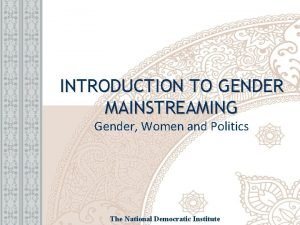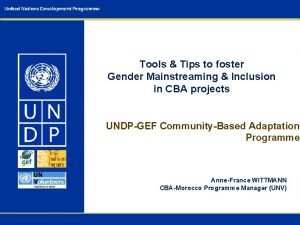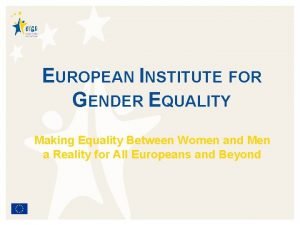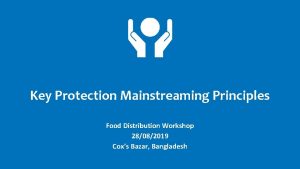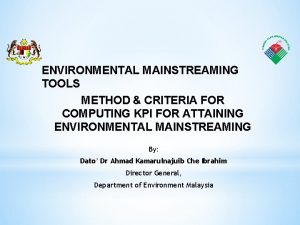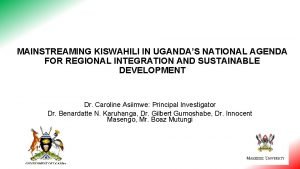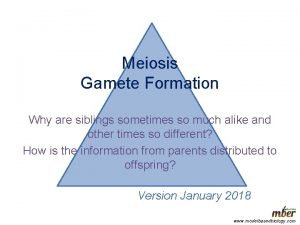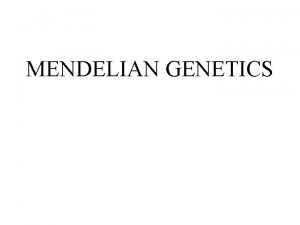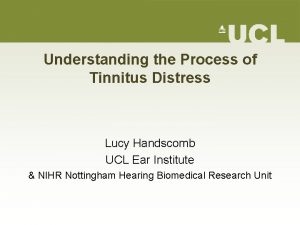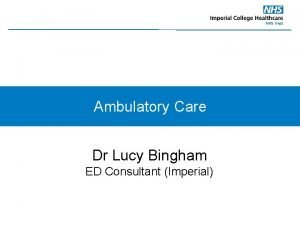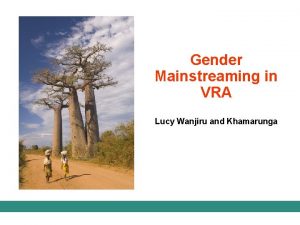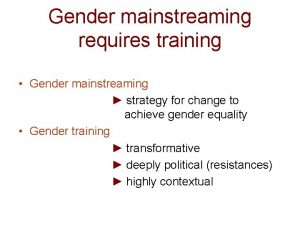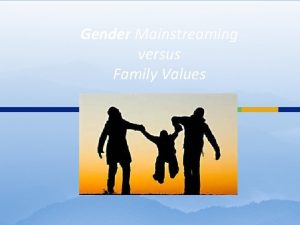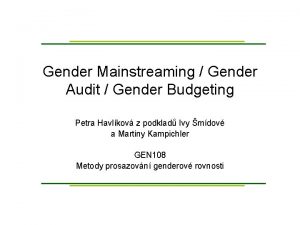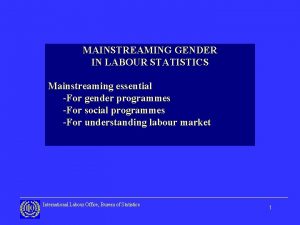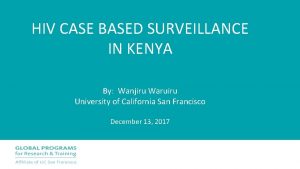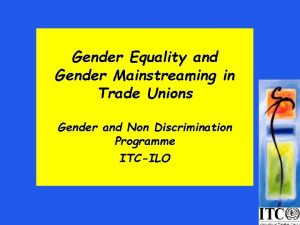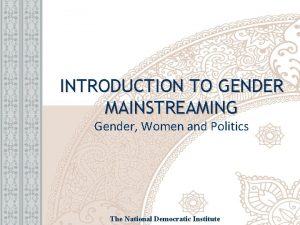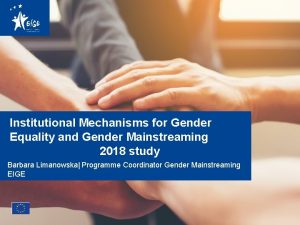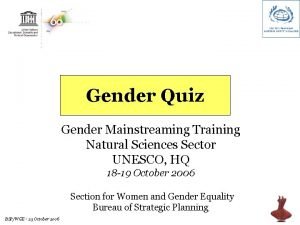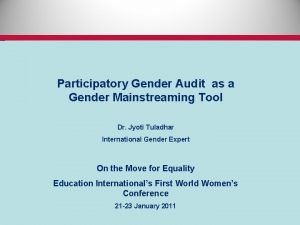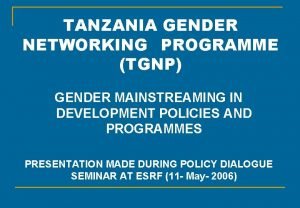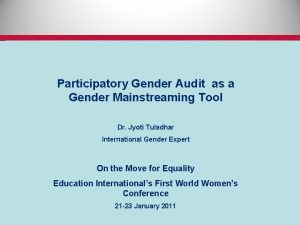Gender Mainstreaming in VRA Lucy Wanjiru and Khamarunga




























- Slides: 28

Gender Mainstreaming in VRA Lucy Wanjiru and Khamarunga

Gender • Gender is a social cultural construct • If a social construct it can also be deconstructed • If gender is mainstreamed in the CBA projects this also offers a chance for deconstruction towards a more equitable society – SD outcomes

Gender Mainstreaming in VRA • Gender mainstreaming is a strategy to promote empowerment of women, boys and girls • Assist enable women to critically analyze their situation • Gain skills and build confidence, move into decision making roles • Aim is to make women agents of change and not recipients of development in transforming gender relations

VRA Participatory Impact Assessment (PIA), Community perception to CC Vulnerability to CC (access to and control over resource) Capacity Cto Adapt (women/boys girls)

VRA defined • a comprehensive M&E framework, including locally defined impact indicators and quantitative portfolio-level indicators. • Taking a semi-structured and context-informed approach, the VRA is designed not only to measure the success of an individual project, but to aggregate (Gender tools) and compare project impacts across a diverse portfolio of project contexts, demonstrating programmewide impact

VRA • The VRA is based on: – a composite of 4 indicator questions (gender indicators could be factored in) – tailored to capture locally-relevant issues that are at the heart of understanding local vulnerability to climate change (knowledge of both men and women). – Questions are posed during a series of 3 -4 community meetings over the period of a CBA project (participation, roles responsibilities, access and control of resources). – Responses to the questions take the form of a numerical score, provided by the respondents during these community meetings (sex-disaggregated data, life histories). • The key quantitative output of the VRA is the degree of change from the baseline score between the preproject baseline, and at project conclusion (outcome increased empowerment of women as access, control over resources as well as decision making, voice).

VRA defined • change in vulnerability. – is assessed through the degree of change in the VRA scores relative to baseline values established prior to the commencement of project activities. • In the context of the UNDP Community-Based Adaptation programme, the aggregated VRA scores of all CBA projects serve as an objectivelevel indicator, measuring achievements in terms of improving capacity of community beneficiaries to adapt to climate variability and change.

Principles of VRA • • • Equity/Equality Flexibility Context specific Community based Capacity building Enables aggregation of results – assess programmatic impact • Poverty reduction • volunteerism

Gender Approaches • Women-in-Development (WID) practical needs – Aims at addressing peoples basic needs, material needs for day-to-day life) Challenges existing gender roles and division of labor • Gender and development (GAD) strategic needs) aims for empowerment – Approach on roles and relationships between men and women addresses power relations aims at promotion of empowerment equity/equality and Sustainable development Though in practices sometimes no fixed lines of demarcation and a project can address both

Key issues around mainstreaming • Gender tools used upfront fitted in overall project/project cycle • Gender approach is not just an activity • Must be included in project phases • Have a clear goal/outcome • There a number of frameworks – Gender assessments – Gender Analysis Framework – Longwe framework for empowerment

VRA –gender entry points • • • Project Design – Targeting Indicators Outputs (how many meetings, etc) General outcomes

Key Phases in VRA • Project design/Situational Analysis • Stakeholder consultation • Implementation • Reassessment phases of SC (participation of women and men/ girls and boys)

Project design/Situational Analysis • Motivation for project is to address a specific programme – Identification of entry point – Review dependent on various perspectives Questions – What is the culture of the area? – How have relationships defined themselves? – What are the gendered issues in the area? – What are the interest how do they differ women men/ girls boys etc?

Gender Analysis Matrix Tasks & skills Women Men Households community Workload Resources/be nefits Socio-cultural issues

Gender analysis Matrix (GAM) • Analysis is used at planning stage to determine whether the potential gender impacts of the projects are desirable and consistence with the project purpose and goal. The impact will be examined in terms of: – Tasks and skills (changes in tasks, level of skills required – Workload – changes in amount and time – Resources/ benefits – changes in access to resources and benefits – Socio-cultural – changes in social aspects of participants and community lives as a result of the project

Gender Analysis • Who does what work? • How does it differ between men and women? • Who has access and control over resources? • Who participates in decision making? • Who’s needs are being meet? Where possible use sex-disaggregated data

Other Issues GAM would help reveal Access/control • It is also important to differentiate between access (such as being able to farm on someone else’s land) and control (owning that land, being able to decide how that land is used). • Having women control the means of production or the decision making process is key to bringing about change.

Stakeholder consultation • • Who are the different stakeholders Opportunity for participation (voice and space) What are their interests? How do this different between the different genders? • How will men and women be affected by proposed project? • What is the capacity for women and men to participate in the project?

Implementation • VRA is both a quantitative and qualitative assessment tool – Sex-disaggregated data (show participation of women, access and control of resource) – Focus groups of women to have an in-depth understanding of their issues around their perceptions and capabilities in terms of CC – Documentation of life histories

Other Key tools • Sex desegregation • In gender analysis, data should be separated out by sex so that it is in a form that enables the impacts on women to be identified separately from impacts on men. • Social construction • The social origins of the historical subordination of women are also important to understand. These are usually manifestations of sexual domination, language and myths. For example, the concepts of defining how we construct manhood and womanhood have been changing throughout history and continue to be changed by society.

Example

Example • Niger government addresses gender gap afrol News, 23 June, 2009 • Women in Niger are still far away from achieving equal rights and opportunities as their male counterparts; the gender gap in Niger is in fact one of the world's largest. The Nigerien government has however approved a larger programme to reduce this gender gap and today was awarded international financing of its efforts. The African Development Fund (ADF) today announced that it had approved of financing parts of Niger's so-called Gender Equity Reinforcement Project, which is designed to "reduce the gender gap" in the country. The ADF US$ 4. 41 million grant is to contribute to enhancing the capacities for design, planning and management of gender activities and to create a social environment that is more conducive to gender equity. • In Niger, poverty particularly affects women, who represent over 50 percent of the population. The imbalance noted between women and men in Niger - mainly regarding legal status, access to resources, responsibilities, participation in decision-making and access to education, health, information and communication and to legal and judicial services - has hindered poverty reduction efforts. According to ADF, the new project "constitutes a major contribution to the government's Poverty Reduction Strategy (PRS) with regard to gender promotion in Niger. " Through the various outputs projected, it is to build the capacities of state agencies and private sector organisations for the "promotion of gender dimensions. "

VRA Question APF Step VRA Indicator In these examples, we consider the case of a community facing increasing drought risks Logic Assessing current vulnerabil ity 1. Vulnerability of livelihood/welfare to existing climate change and/or climate variability. Example: What happens when there is drought? How does this affect you and women and men in your community? Assessing future climate risks 2. Vulnerability of livelihood/welfare to developing climate change risks. Example: What would happen if drought was twice as frequent? How would this affect you and your community? Example: What stands in the way of adapting to increasing drought? What means do you or your community have to manage events occurring more frequently? Formulating an adaptatio n strategy 3. Magnitude of barriers (institutional, policy, technological, financial, etc) barriers to adaptation. Continuing the adaptatio n process 4. Ability and willingness of the community to continue to manage climate change risks Example: Rate your confidence that the (project activity) will continue after the project period. Addresses present climate-related development issues – often the main climate concern of the community. Prepares community for the following question that is specific to anthropogenic climate change by grounding that discussion in a framework that relates it to present impacts. During the second VRA meeting and onwards, this indicator will measure any immediate impacts that project outputs may have had in reducing short-term weather related risks (“no regrets” adaptation measures). Once present context of variability has been discussed, this indicator focuses the community on their perceptions of likely impacts of climate change. This indicator relates to “likely” risks, as identified in the project proposal and CPS. Allows the community to begin to consider long-term viability of livelihood practices in the face of climate change, leading to the following question. During the second VRA meeting and onwards, this indicator will also measure the impact of project outcomes, with respect to longterm climate change risks – confidence that measures in place will help the community to manage future acute or slow-onset climate impacts. This indicator will qualify the above indicator, and focus on the needs of the community to successfully adapt. This indicator will identify policy and practical barriers, forming useful lessons for the country and global programmes. This indicator links project outputs to their respective outcomes in vulnerability reduction – given that projects aim to reduce barriers to adaptation, this indicator measures whether project outputs have been implemented, and if so, if they have had their desired impact. This indicator measures the community’s perception of their ability to continue the adaptation process beyond the defined time period of a CBA project, including considerations of project sustainability as well as community buy-in to the project intervention,

VRA H form

Monitoring and Evaluation Gender lens • Does the project include specific, measurable actions and deliverables related to gender mainstreaming, gender equality and women’s empowerment? • Has the project/programme assessed potential for contributing to gender equality and women’s empowerment through planned activities? • Has sex-disaggregated baseline data been collected? • Has the project/programme assessed the potential for contributing to gender equality and women’s empowerment through planned activities? • Have gender specialists or representatives from women's stakeholders groups participated in all steps of the programme or project cycle? • Have all possible steps been taken to ensure gender equity in the recruitment of project staff and consultants?

Participatory approaches • • • • • Women and men's vision constitute the foundation of participatory local development, Community as an organization Recognizing the functional characteristics of the community and its importance Acknowledging women and local leaders Identifying local institutions and organizations to work with Women and men’s Experimentation Creative use of available resources Trying new ideas and different options Selecting and sharing options that work Valuating local experiences Learning from experience Drawing lessons from experiences Local knowledge management Action learning Linkages and cooperation with external partners Sharing amongst farmers Linkages with service providers and other stakeholders Exposure visits to see new techniques in practice


Thanks
 What is gender mainstreaming?
What is gender mainstreaming? What is gender mainstreaming?
What is gender mainstreaming? Gender mainstreaming
Gender mainstreaming Gender mainstreaming
Gender mainstreaming Strategic gender needs and practical gender needs
Strategic gender needs and practical gender needs Protection mainstreaming principles
Protection mainstreaming principles Environmental mainstreaming tools
Environmental mainstreaming tools Www vra
Www vra Mainstreaming in swahili
Mainstreaming in swahili 5 cfr 213,3102(u)
5 cfr 213,3102(u) How many chromosomes do we have
How many chromosomes do we have Lucy lui with my girl drew
Lucy lui with my girl drew Lucy and maria aylmer
Lucy and maria aylmer St lucy's home raised by wolves questions and answers
St lucy's home raised by wolves questions and answers Lucy calkins writing units
Lucy calkins writing units Lucy pepper
Lucy pepper Tinnitus
Tinnitus Lucy pračovjek
Lucy pračovjek Lucy calkins quotes
Lucy calkins quotes Lucy khairy
Lucy khairy Never let me go what was kathy doing with the magazines
Never let me go what was kathy doing with the magazines Lucy lambert hale
Lucy lambert hale Lucy westenra character analysis
Lucy westenra character analysis Lucy slinger ikea
Lucy slinger ikea Lucy langer md compass oncology
Lucy langer md compass oncology Lucy flesch
Lucy flesch Lucy bingham
Lucy bingham Lucy garratt
Lucy garratt Lucy slinger
Lucy slinger
